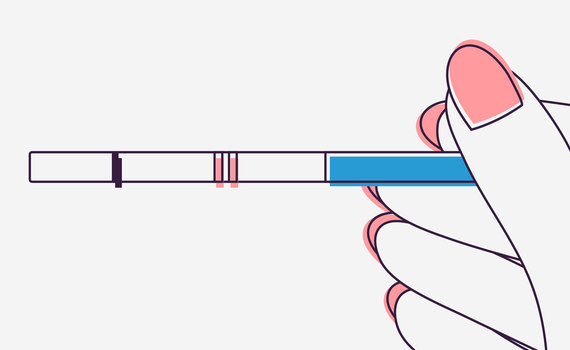
Path To Pregnancy
Luteal Phase Deficiency: How it affects your chances of conceiving
Hannah Loeffelmann
6/16/2020
7 min
Luteal Phase deficiency refers to a diagnosis of a shorter than normal Luteal Phase or second half of the menstrual cycle. It is usually related to low levels of progesterone or progesterone resistance.
If you have been trying to get pregnant for a while and it doesn't work out, or if you have been pregnant and suffered one or more miscarriages in the first trimester, you may be wondering if you might have a luteal phase deficiency (LPD).
What happens during a normal luteal phase?
The luteal phase begins immediately after ovulation. The Luteinising Hormone (LH) which triggers ovulation is also responsible for the formation of the corpus luteum from the follicle of the empty egg membrane that remains in the ovary.
The corpus luteum then produces various hormones that are important for a possible pregnancy, above all the so called “corpus luteum hormone” Progesterone and the female sex hormone Estrogen. Progesterone is one of the most important female sex hormones since among other hormones, it enables the implantation of a fertilised egg in the lining of the uterus and is important for maintaining the pregnancy.
If fertilization does not occur within a cycle, the corpus luteum recedes towards the end of the luteal phase. As a result, hormone production also decreases, the uterine lining is shed and menstrual bleeding begins.
 An average female hormone cycle
An average female hormone cycle
What is a luteal phase deficiency?
A luteal phase deficiency refers to an interruption of the luteal phase in the female cycle that leads to conception problems or repeated miscarriages.
It is estimated that about 63% of women who miscarry repeatedly have a luteal phase defect. This defect can also affect three to four percent of these women who suffer from unexplained infertility.
How to tell if you have a Luteal Phase Deficiency
There is no special test to identify a defect in the luteal phase. Usually, your doctor will start by checking your hormone levels in the blood. This can be followed by an ultrasound of the abdomen and a biopsy of the uterine lining to determine the thickness and quality of the endometrium.
In general it is also helpful to observe your menstrual cycle, especially if you suspect to have LPD. It’s important to do this regularly, since one cycle alone cannot tell you whether you have a luteal phase defect or not- some cycles can be shorter than others, this is normal and unlikely to affect your fertility.
If you notice a short luteal phase regularly though, it can be an indication of LPD. To figure out the length of your luteal phase, simply count the days from your last ovulation to the first day of your menstruation. A luteal phase that is consistently shorter than 10 days can make it difficult for you to become - or remain - pregnant.
For the most accurate results when tracking your cycle we recommend to track your hormones throughout the month, particularly your Luteinizing Hormone (LH), your Follicle Stimulating Hormone (FSH) and Progesterone (PdG). You can do so by using the Pearl Fertility App and tracking these hormones lets you predict and confirm your ovulation and get insight into the different phases of your menstrual cycle.
Symptoms of a luteal phase defect may include:
- A low Progesterone level
- a shorter menstrual cycle (often shorter than 24 days)
- Spotting between periods
- Repeated miscarriages
- Difficulties in getting pregnant
What causes defects in the luteal phase?
The most common cause of a luteal phase defect is low Progesterone levels. As mentioned above, Progesterone is the hormone that is responsible for preparing your uterus to be able to carry a fetus.
After ovulation, progesterone levels rise and remain elevated until you start menstruating. If your progesterone level does not rise enough or falls too quickly before menstruation, you have a shortened luteal phase and early menstruation. Furthermore, a too low level of the Follicle-stimulating Hormone (FSH) during the first phase of the cycle can cause the lining of the uterus to be too thin and weak, preventing fertilization and implantation and instead triggering premature menstruation.
Low levels of the hormone responsible for ovulation, the Luteinizing Hormone (LH), can suppress ovulation and cause low progesterone levels.
By the way: You can track your Luteinizing Hormone (LH) as well as your Follicle Stimulating Hormone (FSH) and Progesterone levels with the Pearl App!
Another form of the luteal phase defect can be caused by a low estrogen level. An estrogen deficiency can lead to the lining of the uterus not being thick enough to support a pregnancy.
LPD may also be related to various other health problems, including:
- Anorexia or excessive sport: Underweight or an extremely low body fat and cholesterol levels suppress the production of various hormones.
- Thyroid disorders
- Endometriosis and Polycystic Ovarian Syndrome (PCOS)
Treatment
Certain drugs can increase your chances of conceiving and staying pregnant, including:
- Clomiphene citrate: this medication can increase the production of the follicle stimulating hormone (FSH), which means that more eggs are released.
- Human Chorionic Gonadotropin, or hCG. This hormone promotes ovulation and stimulates progesterone production.
- Progesterone in the form of tablets, injections, gels or suppositories in order to help build a stronger endometrium.
Although a luteal phase defect can affect your chances to conceive, it can be treated by a combination of drugs and therapies such as those mentioned above. If you are having difficulty conceiving or cannot successfully carry a pregnancy, you should always consult your doctor before starting treatment to make sure it is right for you.

